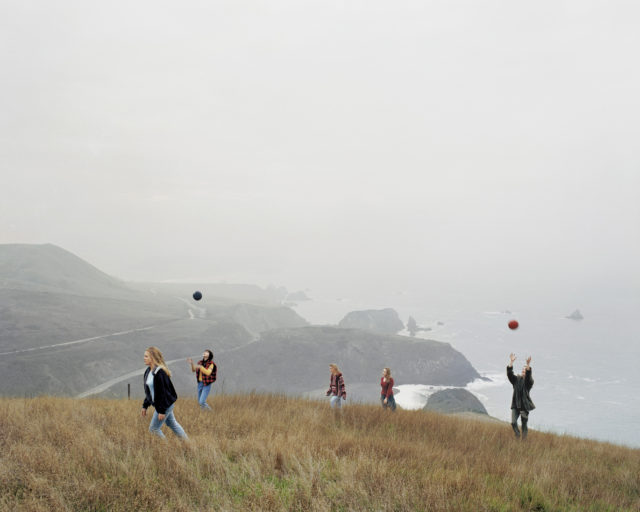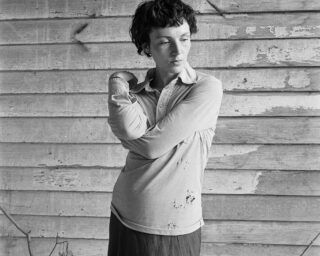Command the Gaze

Amal Said, Purple, London, England, from the exhibition #girlgaze, 2016
Courtesy the artist and the Annenberg Space for Photography, Los Angeles
On January 21, 2017, millions of people participated in Women’s Marches in the United States and around the world, representing 616 diverse marches in 151 cities from Washington, D.C. to Beirut, Lebanon. After a campaign season in which the female body was physically and psychologically abused, scrutinized, judged, and ultimately rejected on media outlets ranging from television to Twitter, women organized around the urgency for a unified and visible stance against the misogyny symbolized by Donald Trump’s ascent to the Oval Office. At the marches, all eyes were on women and their allies, only this time they were the commanders of the gaze.

Dominique Booker, Believe, Berlin, Germany, from the exhibition #girlgaze, 2016
Courtesy the artist and the Annenberg Space for Photography, Los Angeles
Regardless of their economic circumstance, gender identity, physical ability, or nationality, many women share the experience of being watched, and sense intuitively that their worth and safety can be determined by the capricious nature of another’s gaze. This near-universal experience of being defined as an object, instead of an inherently valuable human being, influenced #girlgaze: a frame of mind, currently on display at the Skylight Studios at the Annenberg Space for Photography. As part of the ongoing #girlgaze project, the exhibition argues that a visual politics that challenges the patriarchal definitions of “female” and “woman” must be embedded in the creative work of people who identify as female, and who advocate for women. Put another way, the artists demand that we must go out to the streets and wield the agency we are afforded with empathic and creative power.

Monica Lek, Turkish Delight, from the exhibition #girlgaze, 2016
Courtesy the artist and the Annenberg Space for Photography, Los Angeles
The project is made up of an interactive multimedia exhibition of over 150 images that represents a swath of identities, each from the perspective of “people who identify as girls.” #girlgaze was founded by Amanda de Cadenet, a photographer and CEO of The Conversation, an interview series dedicated to women’s voices, and fashion and art photographers Inez van Lamsweerde, Collier Schorr, Lynsey Addario, and Sam Taylor Johnson, as well as model and activist Amber Valetta. This group of prominent photographers envisioned the social media campaign as an expansive way to challenge and redirect the viewer’s attention away from the female body as an object to be consumed in favor of the concept of female agency and multiplicity. Mobilizing social media, Instagram users became active participants in the movement by sharing and supporting photographs made by female-identified photographers. Those visiting the feed will see images of everyday women, such as a snapshot of a young Brit picking up takeout, as well as overtly political photographs, like a startling image of a domestic abuse survivor.

Luisa Dorr, Maysa, Brazil, from the exhibition #girlgaze, 2016
Courtesy the artist and the Annenberg Space for Photography, Los Angeles
Visitors to the Annenberg exhibition will find the curatorial strategy of the exhibition mimics the experience of discovering pictures via hash tag: photographs are grouped in broad categories. These related images, which include pictures of homeless encampments, race-car drivers, and institutionalized women, are set in conversation with one another on facing makeshift walls, which distinguish the disparate communities without resorting to enclosure. The audience can interact with the material through physical movement, weaving in and out of an open floor plan. In addition, several digital projections are scattered throughout the space and a photo booth welcomes visitors to upload their own portraits to the #girlgaze Instagram account.

Melanie Knight, One Size, Manchester, England, from the exhibition #girlgaze, 2016
Courtesy the artist and the Annenberg Space for Photography, Los Angeles
Though their backgrounds vary, the artists are united by the use of the camera as a mirror on which to reflect, examine, and scrutinize a woman’s relationship to herself and to the world. In a similar way, the multimedia elements of exhibition create an inclusive space in an equitable display of age, beauty, race, religion, class, and ability.

Francesca Milano, New Romantics, Milan, Italy, from the exhibition #girlgaze, 2016
Courtesy the artist and the Annenberg Space for Photography, Los Angeles
When I entered the exhibition, I was overwhelmed by the representation of proud faces not normally portrayed with nuance by the media—the infirm, the addict, the obese, the impoverished—none of whom were shown with shame or lack. I lingered on a particular portrait of a gender-ambiguous subject—a bored face staring at her reflection in a vending machine, a thin teenage mustache lining unsmiling lips. I was hypnotized by the capacity for both the photograph and the photographed subject to hold several identities at once, rejecting narrow judgments and definitions constrained by the mainstream gaze. What’s more, here was a portrait of a person in a relatable, everyday snapshot—not a composed, manipulated, or impossible ideal.

Emma Craft, Daydreaming in Silver, Jackson, Mississippi, from the exhibition #girlgaze, 2016
Courtesy the artist and the Annenberg Space for Photography, Los Angeles
Our weapons in the women’s fight for equal representation and visibility are potent: the pen, the voice, the camera, and our bodies—our presence on the streets. We must declare: I am Woman. Hear Me, See Me, Let Me Be. Our roar must be directed against the patriarchy, the structures of inequality, and the troublesome gaze that objectifies and endangers our bodies. The Instagram account and the #girlgaze exhibition not only demand this of us, but they also testify to the power of images both to inspire and provoke. #girlgaze implores all participants to stand firmly and meet opponents eye to eye. To be loud. To offend acceptable visions of female decency, behavior, beauty, and body image. To march. If photography is a record of light, the work of #girlgaze chronicles the radiance that emanates from women behind the camera and in the frame.
#girlgaze: a frame of mind is on view at the Annenberg Space for Photography, Los Angeles, through February 26, 2017.
Read more from Aperture Issue 225, “On Feminism,” or subscribe to Aperture and never miss an issue.


























